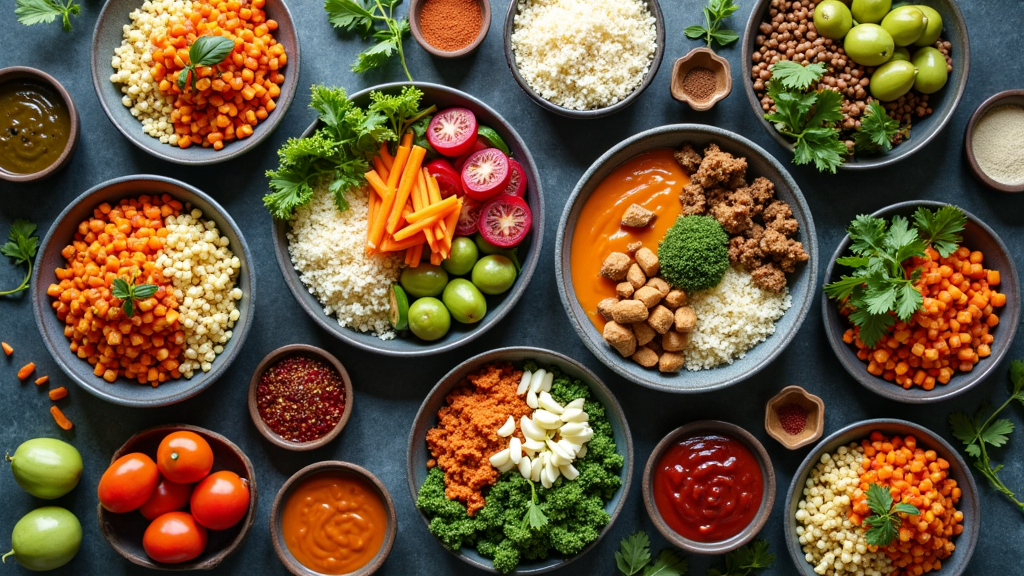If you’ve ever peeked into your fridge and spotted containers of half-eaten dinners, you’re definitely not alone. I’ve learned that getting creative with leftovers is a clever way to reduce food waste, save money, and even eat healthier. Instead of simply reheating the same dish, turning leftovers into a fresh, healthier meal is both satisfying and practical.

Why Eating Leftovers is Worth It
Some people aren’t huge fans of eating leftovers, but there are some real benefits you don’t want to miss. By reusing cooked food, I cut down on food waste, which is a massive environmental problem in every household. It also saves me time. Prepping a new meal every day can be a chore, so leftovers give me a shortcut. Plus, with the right tweaks, leftovers can even be fresher and more balanced the second time around.
Eating leftovers is also a win for your wallet. Grocery bills can pile up, but stretching meals helps my budget without sacrificing flavor or variety. It’s also a great chance to add more veggies or whole grains to create more balanced, nutrientpacked meals. Plus, getting a little experimental with leftovers can lead you to stumble upon flavor combinations you wouldn’t try otherwise.
The 2 2 2 Rule for Leftovers: What It Means & Why It Helps
If you haven’t heard of the 2 2 2 rule, you’re missing a super useful tip for eating leftovers safely. Here’s how it works:
- Within 2 hours: Get leftover food into the fridge within two hours of cooking. Leaving food out longer can let bacteria multiply fast.
- Eat within 2 days: Try to use up leftovers within two days. That way, your meals stay fresher and taste better, and you avoid the risk of spoilage.
- Reheat to 165°F: When you reheat leftovers, make sure they’re piping hot—about 165°F (or 74°C) if you want to be exact. That temperature kills most germs your leftovers might have picked up.
Following this rule is a good way to keep leftovers safe and reduce the chances of getting sick. If you’re in a rush or unsure, just make sure your food is steaming throughout before you take a bite.
How I Turn Leftovers Into a New, Healthier Meal
Turning yesterday’s dinner into something new often feels like a little kitchen challenge, and it’s honestly pretty rewarding to watch it come out even better than before. My approach is simple: add fresh ingredients, switch up the texture, and keep flavors interesting.
Add More Veggies
A big way I level up leftovers is by tossing in extra veggies. For example, leftover chicken or beef works perfectly in a veggieloaded stir fry. I’ll chop up whatever greens I have and add some carrots, bell peppers, or broccoli. If I have bits of roasted vegetables, I’ll stir them into soups or salads for a boost of fiber and color. Don’t be afraid to throw in leafy greens or some grated zucchini—they can lighten up heavier meals and pump up the nutrition.
Switch Up Your Grains
If you’ve got leftover proteins or cooked veggies, swapping the starch is one easy way to make the meal feel brand new. Leftover steak and veggies can get tossed with quinoa or brown rice instead of the usual white rice. If I have some leftover chili, I’ll spoon it over a baked sweet potato or tuck it into a whole wheat tortilla for a quick wrap. Even a handful of buckwheat or farro can bring some variety to your plate. Grains soak up flavors exceptionally well, adding taste and nutrition while making small portions go further.
Upgrade With Healthy Sauces or Seasonings
One of my favorite tricks is to mix up the dressing or add fresh herbs. Even something basic like rotisserie chicken tastes a whole lot different when I add a squeeze of lime, a sprinkle of cilantro, or a spoonful of salsa. Healthy sauces like yogurtbased dressings or vinaigrettes can make leftovers pop without a ton of extra calories or unhealthy fats. Sometimes a few new spices are all it takes, like a dash of smoked paprika or ground cumin. That simple step can take a meal up a notch and freshen its flavor.
Mix, Mash, or Roast
Sometimes a quick remake is all about prep style. I’ll blend leftover cooked squash into a creamy soup or mash up roasted potatoes with steamed broccoli for easy veggie pancakes. Roasting leftover veggies in the oven at high heat gives them new life, especially when tossed with a drizzle of olive oil and spices. Leftover cooked grains like rice or barley are easy to fry up into a quick grain bowl or stir fry. Even cold pasta can be tossed in the skillet and crisped for an entirely new spin.
Best Leftover Meals for a Healthy Boost
Some dishes are just made for leftovers and honestly taste even better the next day. Here are some ideas I keep on repeat:
- Soups and Stews: Flavors deepen overnight, and you can add spinach or beans before reheating for extra nutrition.
- Stir Fries: Toss in leftover protein, pile on extra greens, and add a light sauce for a quick, satisfying lunch.
- Frittatas and Omelets: Eggs are basically a blank canvas. I’ll whisk them with chopped veggies and bits of cooked chicken or beans for a proteinpacked breakfast or dinner. You can get experimental with cheese, herbs, or even salsa on top.
- Grain Bowls: Layer whatever cooked grains you have with roasted veggies, greens, nuts, and a healthy sauce. The possibilities really are endless—try switching up sauces or nuts for different textures.
- Wraps & Tacos: Leftover cooked meats, beans, or tofu go great in whole wheat tortillas. Throw on some shredded lettuce, salsa, or avocado, and you’ve got a filling meal in minutes. Even leftover veggies work well as taco fillings if you top them off with a zesty homemade sauce.
If you’re stuck for inspiration, I recommend jumping into food blogs or Instagram for creative leftover meal ideas. You’ll stumble upon endless ways to reinvent what you already have, from quick grain salads to nextlevel cool baked frittatas. Your leftovers can become an allinone buffet when you learn to mix them in fresh ways.
Things To Watch For When Using Leftovers
Not every leftover can turn into a healthy meal every time. Here are a few things I look out for:
- Soggy textures: Some dishes, such as fried foods, may lose their crispness after sitting in the fridge. Popping them in the oven or turning them into casseroles works better than microwaving.
- Too much salt or fat: Leftovers, especially restaurant food, can be loaded with sodium or oil. I like to bulk up these dishes with plain veggies or grains to balance things out.
- Food safety: Smell and look for any changes before eating. If you’re unsure, it’s often safer to skip it.
- Combining flavors carefully: Sometimes, flavors that work in one dish just don’t mesh in another. I experiment a little at a time and taste as I go.
Kitchen Tools That Make Leftovers More Fun
If you want to get serious about leftover makeovers, a few basic tools really make it easy. A good nonstick skillet can crisp up dayold rice or vegetables. A blender lets you turn roasted veggies into soups quickly. Even a toaster oven gives new life to pizza or casseroles, reheating them evenly without making them chewy. If you like to meal prep, a set of glass storage containers will keep things fresh and lets you spot what you have left at a glance. A sharp knife, a sturdy cutting board, and a few mixing bowls can also go a long way in whipping up healthy remakes fast.
Quick Healthy Leftover Transformations
- Chicken to Salad: Shred leftover chicken and toss it with spring greens, sliced apple, nuts, and a vinaigrette for a fast, light lunch.
- Veggies to Soup: Blend roasted vegetables with a little broth, add spices, and reheat for a simple veggie soup. Top with fresh herbs or a swirl of olive oil for a boost of flavor.
- Rice to Stir Fry: Use cold, leftover rice for a veggiefilled stir fry with soy sauce and scrambled egg. Add bok choy or edamame for color and nutrition.
- Beans to Tacos: Mash up cooked beans, season, and use as filling for tacos or quesadillas along with any extra veggies.
- Roast to Grain Bowl: Slice leftover roast meat thin, serve over brown rice or quinoa, and top with a zesty salsa or basil pesto. Add sliced cucumber or tomatoes for crunch.
I always try to pair a new flavor or texture with whatever’s left to keep things interesting and balanced. You’ll be surprised by how easy it is to bring together a meal that tastes nothing like the night before.
Frequently Asked Questions
What meals work best for leftovers?
Soups, chili, casseroles, and grain bowls are perfect for leftovers. Ingredients blend and deepen in flavor when they sit overnight, plus they’re easy to add to or reinvent later. Roasted meats, cooked grains, beans, and simply prepared vegetables usually reheat well and give you loads of ways to set up new meals at home or work.
What is the 2 2 2 rule for leftovers?
The 2 2 2 rule is a safety trick: Store cooked food in the fridge within two hours, eat it within two days, and reheat it to 165°F. This helps stop bacteria growth and keeps your food tasting its best.
How do I turn leftovers into a new meal?
Switch up the flavor or texture by adding fresh veggies, swapping grains, or using a new sauce. Try turning veggies into soups, stuffing tortillas with leftover meat or beans, or building grain bowls with whatever you have on hand.
Why is it important to eat leftovers?
Eating leftovers saves money, cuts down on food waste, and helps you eat healthier by making homecooked meals doable. By keeping an eye on safe storage and cooking practices, you get the most out of every meal and boost your healthy eating without much effort.
If you stick with a few easy rules and get a bit adventurous, leftovers will stop feeling boring and start saving you time, money, and stress. Jump into your fridge—you might just stumble upon your new favorite meal.




